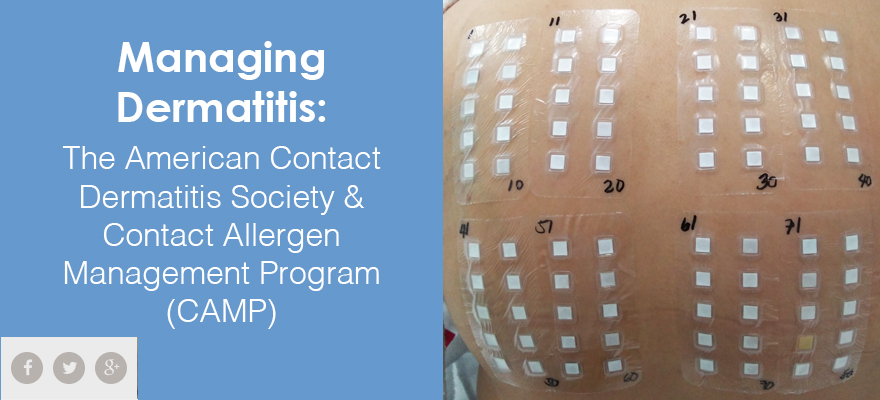What is the American Contact Dermatitis Society? What is the Contact Allergen Management Program? And how do they help manage dermatitis? We spoke with Jenny Murase, Chair of the CAMP Optimization Task Force of the American Contact Dermatitis Society, Associate Clinical Professor at UCSF, and Director of the Patch Test Clinic at the Palo Alto Foundation Medical Group to learn more.
1) The American Contact Dermatitis Society is an organization for dermatologists who specialize in contact dermatitis. Why is the ACDS necessary?
The ACDS provides a critical role in the dermatology and allergy community because our society is a group of subspecialists who provide diagnostic testing for dermatitis (rash). When someone gets a rash that is chronic (lasts a long time) and recalcitrant (does not respond to therapy), it is possible that there is an exogenous (outside) component to the rash. Irritant contact dermatitis (where the protective oil layer of the skin is stripped, such as with water, soap, and detergents) and allergic contact dermatitis (an allergy that has developed to items coming in contact with the skin) are both possible. Through our patch testing, we help to uncover what could be driving triggers for rash. The ACDS provides dermatologists and allergists with tools that they need to educate their patients during this testing, with access to handouts describing allergens and the Contact Allergen Management Program (CAMP) to create a safe list of products for patients that do not contain their allergens.
2) What are some common allergens?
Common items to detect in patch testing include items in skin care products like preservatives (that prevent bacteria from growing in skin care products), fragrances, surfactants (that cause skin care products like soaps and shampoos to bubble), and emulsifiers (that provide the oil-to-water feel to products) as well as hair dyes, textile dyes, metals, topical medications like antibiotic ointments or topical steroid ointments, plastics, rubbers, adhesives, among many other allergens.
3) What is a patch test and why is it useful?
Patch testing is a diagnostic test that looks for delayed hypersensitivity reactions, which means rashes on the skin that develop in response to an allergen coming in contact with the skin that the patient has developed memory immune cells to recognize and respond to. A classic example would be poison oak, where a patient is exposed and then develops a red rash within days because they have immune cells that respond to the poison oak allergen. This is opposed to an immediate hypersensitivity reaction mediated by histamine which results in an immediate reaction on the skin, like contact hives (urticaria) or an anaphylaxis reaction (like latex allergy for example). Because this is a delayed reaction, it takes a few days to read the test. Patches are placed on the back, they are removed after 48 hours, and then there is an interpretation that occurs also at 3-7 days after placement to see how the patient is responding to the allergen.
4) What is the best way to avoid skin allergies?
The best practice is avoidance of the allergen, if at all possible. We provide patients with a safe product list through CAMP for skin care products ranging from shampoos, soaps, moisturizers, and even laundry soap and detergents. We also provide ways to avoid non-skin care product allergens like rubber in certain rubber gloves or textile dye allergy through dye-free clothing. In addition we provide dietary tips on how to avoid consuming some allergens that can cause a “systemic contact dermatitis,” including allergens like tocopherol, propylene glycol, balsam of peru, cobalt and nickel.
5) Is sensitive skin common?
Sensitive skin can mean a variety of things to patients. Someone who has had hives (urticaria) or eczema (atopic dermatitis) can feel that they have sensitive skin since their skin breaks out in rashes easily. It can also mean that they have become more and more sensitive to skin care products throughout their life by developing allergic contact dermatitis slowly over time, and diagnostic testing like patch testing can help to clarify what is driving the rash and/or the itch.
6) What is CAMP, why was it created, and how does it help patients who’ve had a patch test?
CAMP is the Contact Allergen Management Program. It was created for ACDS members in order to be able to provide a safe list of products that do not contain the allergens that the patient is allergic to or any of the cross reactants. It can be difficult to label read if you do not know all the different chemical names and cross reactors. For example if you tested positive to formaldehyde, you needs to avoid ingredients like Quaternium 15 and DMDM Hydantoin. This takes the guess work out of finding safe products for the patient because it is easier to look for items on their safe list and buy those than try to process all the possible reactions.
7) We heard there’s a new app for CAMP?
In order to get access to the CAMP app, your dermatologist needs to be a member of the ACDS. The CAMP will generate codes that you place into the app when it is downloaded to the phone, and using these codes, a list of products that do not contain those allergens can be developed.
We publish articles by doctors who wish to provide helpful information to their patients and the public, or who respond to our requests to use them as professional resources. Doctors may or may not prefer to remain anonymous and we respect this preference. These resource articles do not in any way imply an endorsement by the physician of VMVinSKIN.com or VMV HYPOALLERGENICS® — they are intended for informational purposes only. While written by or with resource professionals, these articles should not be relied on for diagnostic accuracy or applicability to your particular skin, which requires an in-person ocular consultation with a qualified physician and possibly additional diagnostic tests.
For more on what hypoallergenicity is click here.
For more on VMV HYPOALLERGENICS®, who we are, our skintegrity, and our Hypoallergenicity, we invite you to browse through About VMV.
For more information about the Contact Allergen Management Program, ask your doctor or contact the American Contact Dermatitis Society.
To find a dermatologist who does patch tests in your area click here.
Click here to learn more about the VH-Rating System.
Click here to read the VH-Rating System’s proven efficacy.
Click here for information about patch tests.





